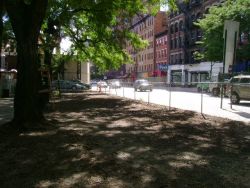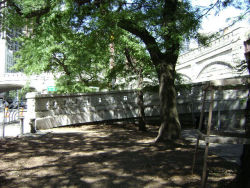Honey Locust Park
Honey Locust Park
What was here before?
Located at the Manhattan entrance of the Ed Koch Queensboro Bridge, this park was formerly part of the property granted to John Danielson in 1676. After a series of owners, the property became Thomas C. Pearsall’s farm in the early eighteenth century. In 1809, Pearsall also acquired the deed for the Mount Vernon Hotel and property, which bordered his farm to the north. The elegant stone carriage house that accompanied the mansion remains on East 61st Street as a landmarked museum. The Mount Vernon property was leased to various tenants until Pearsall died in 1820 and it was passed to his seven children, who in turn sold the property in 1824 in what became a series of owners.
Maps show buildings lined this block in 1891, prior to construction of the Queensboro Bridge completed in 1909. After the bridge was completed, this site was a flat, paved space with benches against the bridge’s stone archways on 59th Street and street trees planted along the same axis.
How did this site become a park?
This park is under the jurisdiction of the Department of Transportation (DOT). In September 1938, DOT issued a permit to NYC Parks that allowed indefinite use of the space as a public park. The park was informally called Gateway Park, possibly due to its proximity to the bridge roadway entrance, until it was formally named in 1996. For many years it was maintained by the community as a neighborhood garden and sitting area.
In 1980, NYC Parks requested to extend the permit boundaries to include the entire block along 59th Street, between First and Second Avenues. The park was extended to its current boundary, though bridge maintenance and utility vehicle parking necessitated continued joint occupancy of the site until the Department of Environmental Protection, which had been using it for staging nearby water main improvements, relinquished the site in 2018.
In 2022, NYC Parks redesigned the park to include seating and new plantings that offer respite from the imposing bridge and surrounding traffic, while allowing DOT access to perform maintenance and repair to the bridge.
Who is this park named for?
NYC Parks Commissioner Henry Stern formally named the site Fourteen Honey Locusts Park in October 1996, ostensibly after the Honey Locusts that stretched the city block. The name was ultimately shortened to Honey Locust Park in 2019.
The honey locust tree, originally restricted to the Mississippi Valley, is now found along the eastern coast. In its natural variety, it sprouts clusters of long thorns from its trunk. Cultivated varieties, however—like those in this park—have no thorns. The wood of the honey locust is heavy and durable, making it ideal material for railroad ties, fence posts, and agricultural implements. The honey locust’s fruit provides food for deer, rabbits, and squirrels.
Check out your park's Vital Signs
Clean & Safe
Green & Resilient
Empowered & Engaged Users
Share your feedback or learn more about how this park is part of a
Vital Park System



